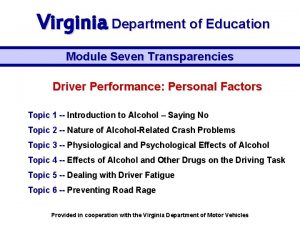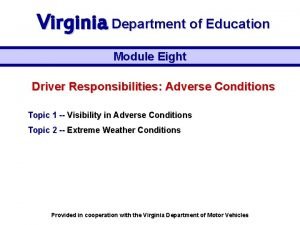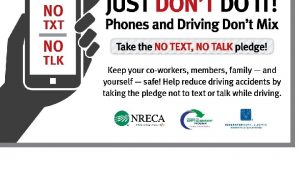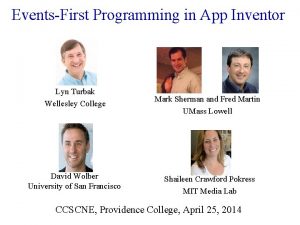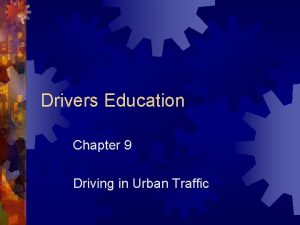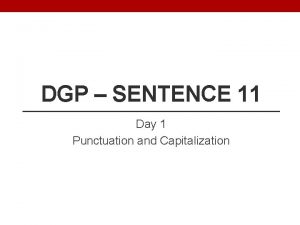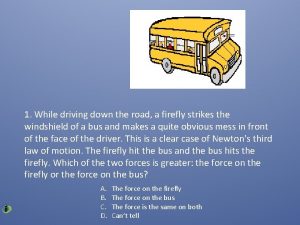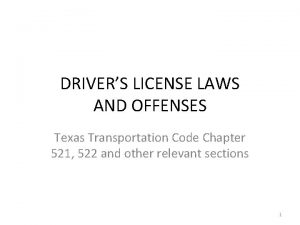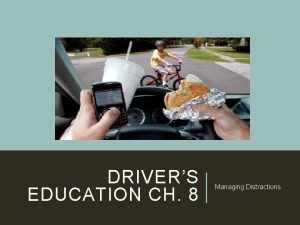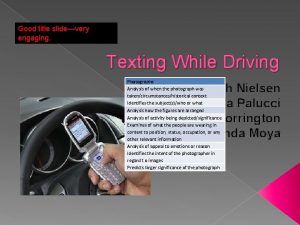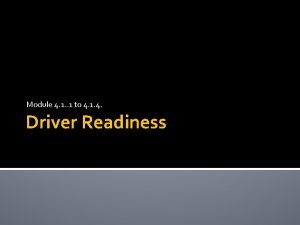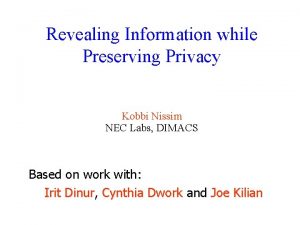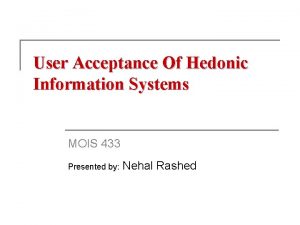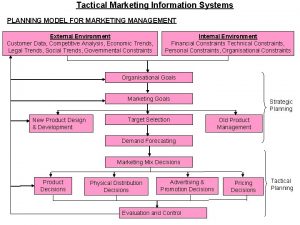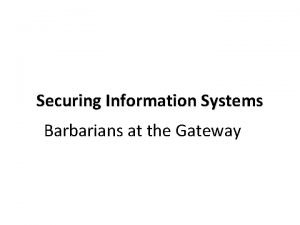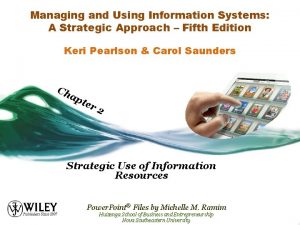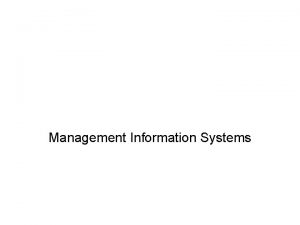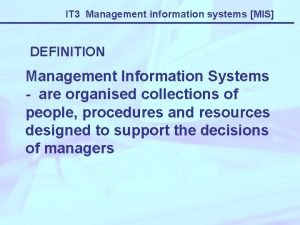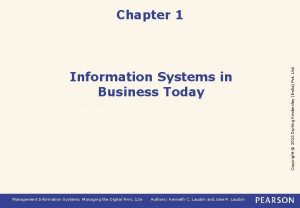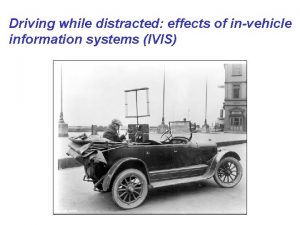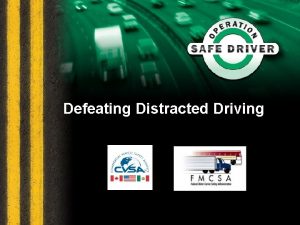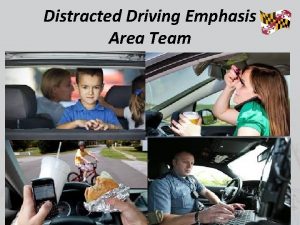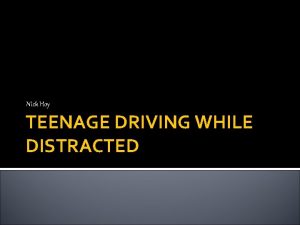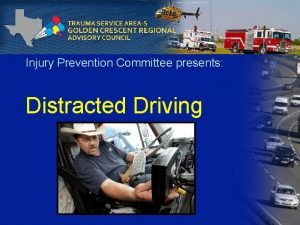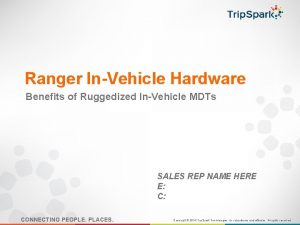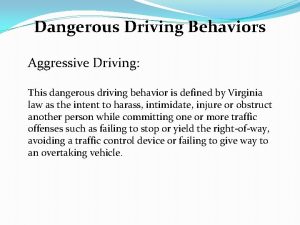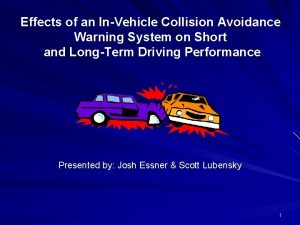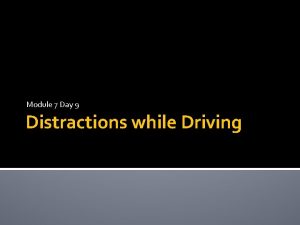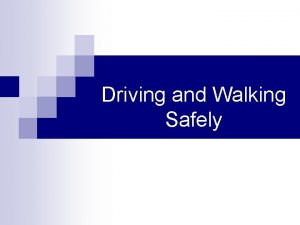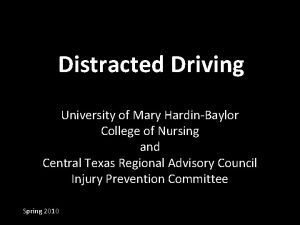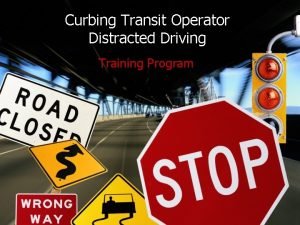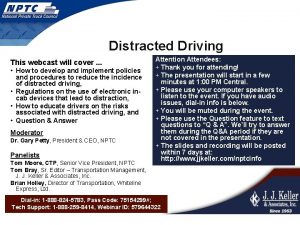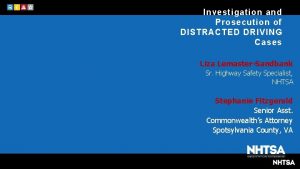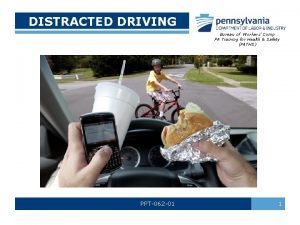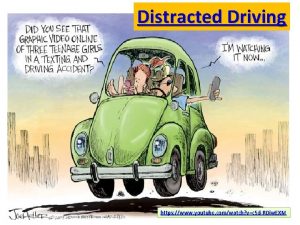Driving while distracted effects of invehicle information systems





































- Slides: 37

Driving while distracted: effects of in-vehicle information systems (IVIS)

Distraction as a cause of accidents: Stevens and Minton (2001): 5, 740 fatal accident reports from 1985 -1996: 2% involved distraction - passenger, radio, eating. Lansdown (2002): recorded drivers' eye-movements in a simulator while using the radio-cassette. Actions took over half a second - 30 ft. at 40 mph. Hanowski et al. (2005): naturalistic study of truck drivers. 7% of "2737 critical incidents" due to distraction. Risk depends on frequency, time to complete an action, and visual demand. Wallace (2003): distraction may account for 10 -30% of all accidents - a significant threat to road safety.

Stutts et al. (2003): 70 drivers with instrumented cars: Percentage of drivers engaging in distracting activities during 3 hours of driving, and percentage duration of these activities while in motion: Potential Distraction % of Subjects % of Total Driving Time Talking on cell phone 30. 0 Answering cell phone 15. 7 Dialing cell phone 27. 1 Eating, drinking, spilling 71. 45 Preparing to eat or drink 58. 6 3. 16 Manipulating music/audio controls 91. 4 1. 35 Smoking (includes lighting and extinguishing) 7. 1 1. 55 Reading or writing 40. 0 0. 67 Grooming 45. 7 0. 28 Baby distracting 8. 6 0. 38 Child distracting 12. 9 0. 29 Adult distracting 22. 9 0. 27 Conversing 77. 1 15. 32 Reaching, leaning, etc. 97. 1 Manipulating vehicle controls 100. 0 Other internal distraction 67. 1 External distraction 85. 7 1. 30 3. 78 1. 62

The mobile office (2012). . .

Texting and driving: RAC Foundation (2008, UK): 45% of drivers admit to texting while driving. Pennay (2006, Australia): 75% of 18 -25 year olds text while driving (36% of over-25 year olds). Harrison (2011, US), Atchley et al (2011, US): 90% of college students text while driving. IAM/TRL (2012, UK): 8% of drivers use smartphones while driving (24% of 17 -24 year olds).

Theoretical perspectives on the risks of mobile phone use (models of dual-task performance):

Schneider and Shiffrin (1977): Distinction between "automatic" and "controlled" processing. Norman and Shallice (1980, 1986): Lower-level "contention scheduling" and higher-level "supervisory attentional system". Could experienced drivers rely on contention scheduling, leaving plenty of spare capacity for other tasks (hazard perception, radio, phone use)?

Hockey's "compensatory control theory": Drivers might preserve performance on "primary" drivingrelated tasks (e. g. lane-keeping) by withdrawing resources from "secondary" tasks (e. g. use mirrors less). Problem is ensuring drivers assign priority to the correct tasks (Cnossen, Meijman and Rothengatter 2004). Loop A: routine/welllearned behaviour handled b y automatic processes. Loop B: activated if mismatch between actual and desired performance change task goals or change amount of effort expended.

Wickens' (1984) "multiple resource theory": task interference affected by 3 factors mode of information input (auditory, visual, tactile); type of coding (spatial or verbal); type of response (manual or visual). Driving involves visual input/ spatial code/ manual output. Phoning involves auditory input/verbal code/vocal output. Therefore should not compete for the same resources.

Empirical data on risks of mobile phone use: 1. Accident statistics 2. Driving simulator studies 3. Real-world driving

Studies of accidents involving mobile phones: Difficult, since phone-use was rare until recently. Similar pattern in many countries: 60 -70% of drivers admit to phoning while driving (15% use hands-free). Few think using a phone is hazardous. Accident risk may quadruple (Redelmeier and Tibshirani 1997) or double (Laberge-Nadeau et al 2003). Blattenberger et al (2012): 1980 -2005 fatal accident rates linked to trends in alcohol and mobile phone use. Wilson and Stimpson (2010): 28% increase in distracted driving deaths between 2005 -2008 (primarily linked to increase in texting).

Redelmeier and Tibshirani (1997): Case-control study. Itemised phone bills of 699 Toronto drivers who owned a phone and reported a crash. Estimated when the accident occurred, and whether the phone was in use at the time. Compared this time to a comparable time-period on the previous day. If phone-use increases accident risk, more calls should occur in the period before the collision than in the corresponding period on the accident-free day. If phone-use does not increase accident risk, should be no systematic difference in phone use between the two periods.

Redelmeier and Tibshirani (1997) (cont. ): Risk of a collision within 10 minutes of using a phone was 3 to 6. 5 times greater than when a phone was not used. 24% had used their phone during the 10 minutes before their accident. 5% had used their phone during the same period the day before. Collision risk was similar for all types of driver (young or old, experienced phone users or inexperienced users). No difference between hand-held and hands-free.

Laberge-Nadeau et al. (2003): Questionnaire to 22, 942 male and 13, 136 female Quebec drivers. 41% of males and 25% of females owned phones; 90% used it while driving. 16% of users had an accident in previous 2 years, compared to 13% of non-users (no sex-differences). Odds. Ratio = 1. 3 - 1. 4, depending on age-group. The greater the use, the worse the risk. Frequent phone users (>100 calls/month) had twice the accident risk.

2. Driving simulator studies: Alm and Nilsson (1994): Emergency braking in response to a symbol in road ahead. With/without Working Memory Task on hands-free phone. RT on easy (straight) roads increased from. 95 to 1. 3 sec. ; no difference on hard (curvy) roads. Alm and Nilsson (1995): Emergency braking in response to sudden braking by car in front while using/ not using hands-free phone. 29 year-olds: RT increased from 1. 6 to 2. 2 sec. 68 year-olds: RT increased from 2 sec to 3. 5 sec. No compensation by increasing headway.

Strayer and Johnston (2001): RT to red light while tracking with a joystick. Listened to radio, conversed with absent experimenter or undivided attention. No difference between hands-free and hand-held phones: missed 7% of red lights, compared to 3% in undivided attention condition, and 40 ms increase in RT. Radio condition (and passively listening to a book being read) were similar to undivided attention condition. Conclusion: merely listening to information does not significantly impair performance - active engagement in conversation via a phone is the problem.

Strayer, Drews and Johnston (2003): Motorway driving in simulator: car following in heavy or light traffic, in silence or with natural conversation. Heavy traffic/phone use condition: 180 msec slower to react to lead car's braking. Increased headway, but inadequate to cope with impairment. 3 rear-end collisions. In heavy traffic, other vehicles may have distracted drivers' attention from the lead vehicle - "change blindness" effects.

Beede and Kass (2006): Simulated driving, with/without a primarily visuo-spatial conversation on a hands-free phone. Also with/without an arrow detection task. Phone use narrowed attention: poorer on peripheral red arrow detection task. More violations, more attention lapses, less frequent lane changes, but quicker RT to events in line of sight (by 0. 03 sec).

3. Real-world driving: Brookhuis, de Vries and de Waard (1991): Effects of hands-free and hand-held phones on motorway, ring-road and city driving. Drove instrumented car, following experimenter's car. No significant effect on RT to lead car's braking; but small N (12). Phone-use increased workload (heart-rate). Effects at tactical and strategic levels, not at operational level - affected speed choice and mirror-use, but not lanekeeping (except when dialling).

Patten, Kircher, Ostlund and Nilsson (2004): Effects of hands-free and hand-held phones on peripheral detection task during undemanding (motorway) driving. Task: respond to small lights appearing on windscreen. Professional experienced drivers, used to mobile phones. No difference between hands-free and hand-held phones. Undivided attention: RT = 584 msec, 4% of lights missed. Both phones, simple arithmetic: 656 msec, 15% missed. Both phones, complex arithmetic: 845 msec. Small, but inadequate, compensation by speed reduction in hand-held condition.

Cooper and Strayer (2008): Similar impairments for experienced and inexperienced users. Strayer, Drews and Crouch (2006): RT was worse when using a phone than after 0. 08% alcohol. Horrey and Wickens (2006): Meta-analysis of 22 studies. RT increased by. 13 seconds. No difference between hand-held and hands-free. Caird et al (2008): Meta-analysis of 33 studies (2000 participants). RT increased by. 25 seconds, with no accompanying increase in safety margins.

Why does mobile phone use increase accident risk?

Recarte and Nunes (2000): effects on eye movements: Verbal and spatial imagery tasks while driving. Both increased pupil dilation (workload indicator). Both tasks reduced gaze distribution (spatial task by 40% horizontally and 60% vertically). Spatial task produced "eye freezing" - long fixations. Both tasks reduced number of glances to mirrors.

Effects of visual imagery on driving performance (Briggs, Hole and Land 2007): Conversation often involves imagery. Imagery and perception share processing systems. Effects of mobile phone conversations on driving might arise from the imagery component of the conversation. "What did you do yesterday? " "Oh nothing much dear, just picked up a couple of hitch-hikers. . . "

1. Effects of imagery on hazard detection: High and low imagers. Primary driving-related task: video-based hazard detection. Secondary task: sentence verification, with imageryinducing or non-imagery-inducing statements: ‘In a rowing boat, the rower sits with his back to the front of the boat' versus ‘The official language of Mexico is Spanish’.

Number of hazards detected: Mean number of hazards detected High imagers Low imagers Undistracted Imagery No imagery Experimental condition Distracted participants detected fewer hazards. Distraction worse if it involved imagery. Effects worst for high-imagers with imagery distraction.

Reaction times to respond to hazards: Time to respond to pedestrian stepping in front of vehicle: Mean RT (seconds) High imagers Low imagers Undistracted Imagery No imagery Experimental condition Distracted participants much slower to react. Imagery-distraction worse than non-imagery distraction. Unaffected by participants' imagery ability.

Hancock, Lesch and Simmons (2003): Combined phone use with emergency stopping decision on test track. Drivers' RTs slowed by dual-task; therefore brake harder. (a) Normal driving = "long periods of sub-critical demand interspersed with moments of crucial response, or hours of boredom and moments of terror". (b) Emergency responses are not over-learned, and do not allow drivers to adapt their control actions. Stop light detection rates: No phone: 95% Phone: 80%

Gugerty, Rakauskas and Brooks (2004): Simulated driving while performing a verbal task with a partner who was present or remotely located. Remote interactions were slower (more difficult) and degraded situation awareness more. Crundall, Bains, Chapman and Underwood (2005): Driving in silence, in conversation with passenger, or in conversation on mobile phone. Passenger sighted or blindfolded. Similar distraction from blindfolded passenger and mobile phone - both worse than sighted passenger. Conversation suppression by sighted passengers.

Drains on processing resources maintain conversation without visual cues mobile phone problem solving Working Memory for conversation mental imagery emotional effects of conversation Immediate consequences Ultimate consequences compensatory behaviours - drive slower, use mirrors and indicators less compensatory behaviours - rely more on expectations reduced eye movements increased RT to unexpected hazards less situational awareness poorer hazard detection earlier onset of fatigue lane-keeping driving vehicle control situational awareness hazard anticipation hazard detection increased accident risk from failure to cope in critical / unexpected situations

Hyman et al (2010): the case of the unicycling clown: Only 25% of phone users noticed the clown (compared to 61% of MP 3 users).

Drivers' beliefs about the risks of using a mobile phone while driving:

Strayer, Drews and Johnston (2003): 50% of the drivers in their study thought their driving was unaffected by phone use, a belief unsupported by the data. Said they had noticed other people driving erratically! Lesch and Hancock (2004): Rated confidence in coping with distractors while driving was correlated with actual driving performance in males, but not females (whose emergency braking RTs were also more affected by distraction). Horrey and Wickens (2008): Drivers are unaware of how much they are impaired: no correlation between self-rated and actual driving performance.

Conclusions: In-car distractions pose a significant threat to road safety. Mobile phones particularly problematic, because of (a) cognitive burden of maintaining conversation; (b) remote conversers are unaware of driver's situation (and hence are more distracting than passengers); (c) visual imagery in conversation may compete directly with visual perception of surroundings; (d) involve relatively extended periods of distraction. Increases RT by c. . 5 sec, reduces situational awareness. Hands-free are no safer than hand-held because the primary problem is distraction, not loss of vehicle control.

Problem of in-car distraction will get much worse: Satellite Navigation systems, emailing, internet access, warnings generated by collision-avoidance systems, lanedeparture systems, augmented road-signs, traffic flow information, etc. Microsoft aim to turn cars into mobile offices; telematics is a lucrative market. "Hands-free / voice-based" is not necessarily safe cognitive demands of auditory IVIS interfere with visual processing during driving (Blanco et al. 2006, Harbluk et al. 2006).

Garmin Nuvi 1690 - available now. . .

Norman (2004, 2005): Humans are inherently distractible Good for survival on the Savannah. . . Bad for survival on the M 25 ! Photos © Kristin Oguntoyinbo/University of North Carolina Highway Safety Research Centre
 Drivers ed module 7 topic 4
Drivers ed module 7 topic 4 Curriculum guide for driver education in virginia module 8
Curriculum guide for driver education in virginia module 8 Distract noun
Distract noun Appinventorr
Appinventorr How can you best use the ipde process in city driving
How can you best use the ipde process in city driving Passengers can help a driver manage emotions by
Passengers can help a driver manage emotions by Ccscne
Ccscne Use the driving in city traffic terms
Use the driving in city traffic terms Were verb berapa
Were verb berapa A large truck and a volkswagen have a head-on collision
A large truck and a volkswagen have a head-on collision Section 521.222 (d)(2) transportation code
Section 521.222 (d)(2) transportation code Chapter 8 managing distractions answers
Chapter 8 managing distractions answers Texting while driving cartoon
Texting while driving cartoon While driving anna litical
While driving anna litical Whats 20 questions
Whats 20 questions What can you do to control your emotions while driving
What can you do to control your emotions while driving Do while loop adalah
Do while loop adalah âq1
âq1 Positive effects of information technology
Positive effects of information technology Decision support systems and intelligent systems
Decision support systems and intelligent systems Dicapine
Dicapine Embedded systems vs cyber physical systems
Embedded systems vs cyber physical systems Engineering elegant systems: theory of systems engineering
Engineering elegant systems: theory of systems engineering User acceptance of hedonic information systems
User acceptance of hedonic information systems Tactical information systems
Tactical information systems Securing information system
Securing information system What is retail management information system
What is retail management information system Principles of business information systems
Principles of business information systems Managing and using information systems
Managing and using information systems Types of information systems
Types of information systems Management information system chapter 1
Management information system chapter 1 Mis systems examples
Mis systems examples What technologies are used by ups
What technologies are used by ups Definition of mis
Definition of mis Survival in information system
Survival in information system Introduction to information systems 6th edition
Introduction to information systems 6th edition Fundamentals of information systems 9th edition
Fundamentals of information systems 9th edition Fundamentals of information systems 9th edition
Fundamentals of information systems 9th edition
